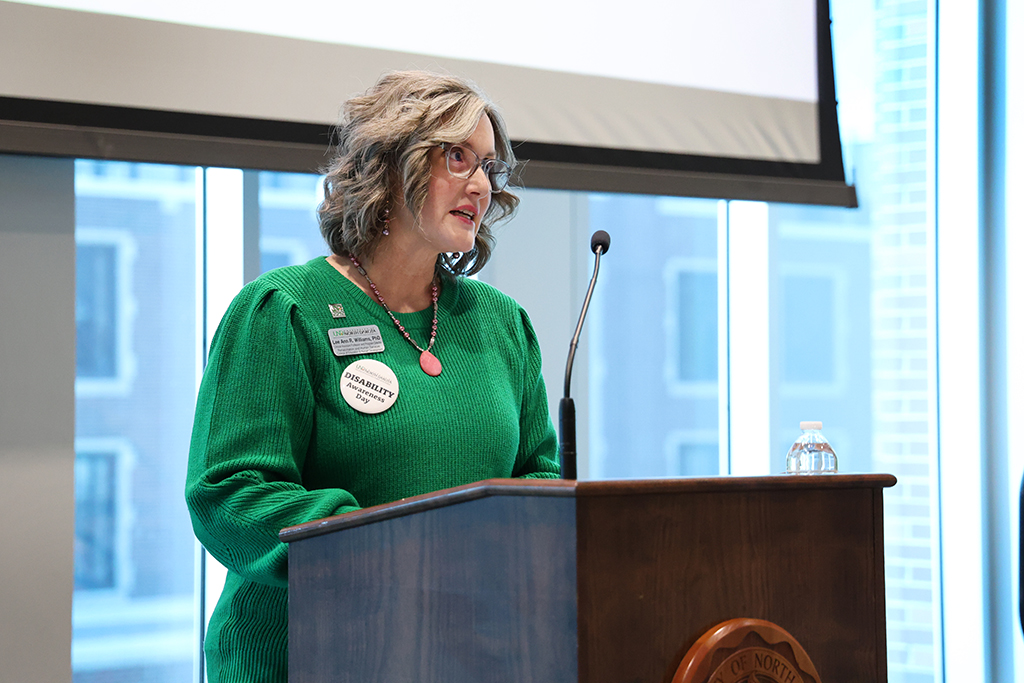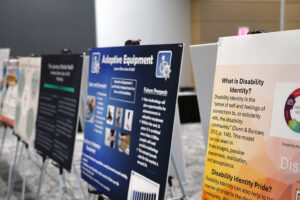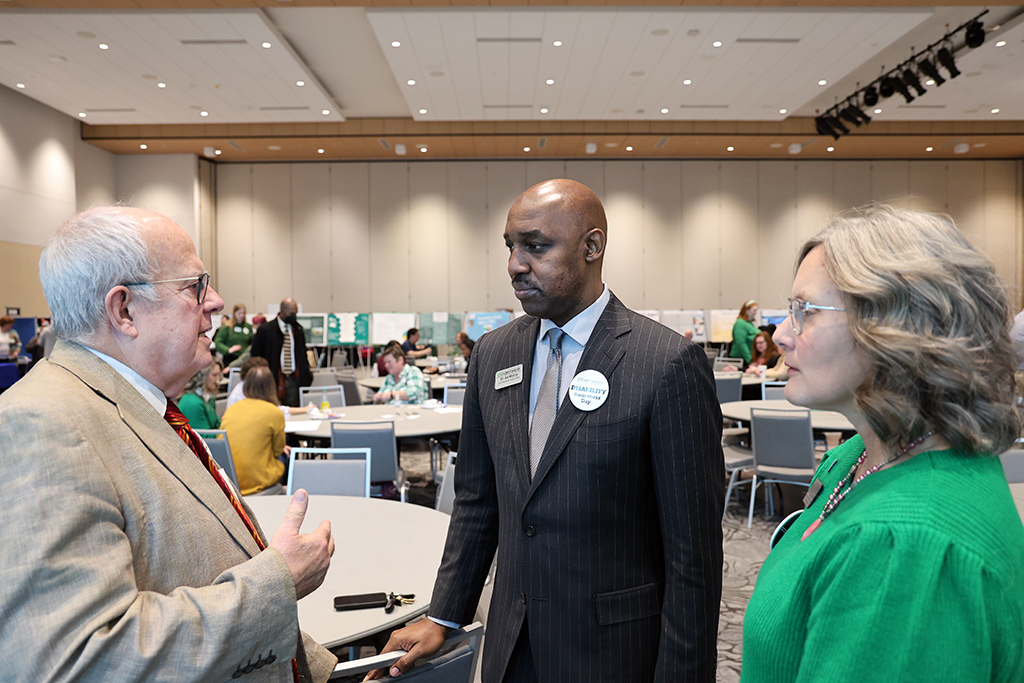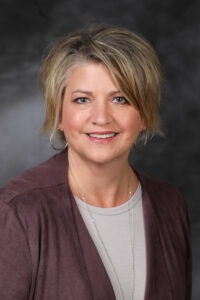Inaugural Disability Awareness Day is for learning
Global expert ‘reimagines’ movement where excluded groups join forces to advance change

Disability rights have come a long, long way since the shameful, shadowy days of institutional oppression, a sociologist and leading expert in inclusive learning said this week at UND. But, he added, there’s still much work that needs to be done.
Alan Bruce, keynote speaker at UND’s first Disability Awareness Day on Monday, told the crowd inside the Memorial Union that the powerful momentum sparked by the Americans with Disabilities Act in 1990 has stalled in recent years, and “it’s time to reimagine where we’re going in the future.”
“For the people working in the disability movement, there is a crisis because we’ve run out of steam,” said Bruce, CEO of Universal Learning Systems Ireland, an organization that focuses on research, training and evaluation in inclusive learning worldwide. “Yes, we’ve had great achievements with ADA — putting things on the agenda like building accessibility, new regulations and norms — but we haven’t gone further, partly because the world changed around us.
“Just at the time we understood the need for placement in jobs, the whole jobs market changed when the market crashed in 2008, and I think we’re still feeling that impact today.”

Breathing new life into movement
Many countries were looking to America as the model for change, Bruce explained, but the financial tailspin led to massive cost-cutting and slowed the speed of proactive action.
“Now, people are finding that they still need to do what they were doing before, but with less money and fewer resources,” he said. “That has been soul-destroying for many people in the disability movement. It’s defeating. People have tended to retreat — to do small things — and we’re losing that great fervor that came with the first Berkeley (Calif.) Independent Living Center.”
So, what’s the answer?
One possibility, Bruce says, is to look for ways to partner with other groups and connect parallel issues — for instance, social justice issues based on gender, race and age discrimination.
“We can work together to do a lot of things,” he added. “We don’t have to look at all of these as distinct issues. They can overlap, because after a while, you realize people coping with these other issues are facing a lot of the same challenges many disabled people are facing.
“People sometimes will say, ‘Well, we achieved ADA, we can go home.’ No, you can’t go home. Mainstreaming is not the destination — it’s only the starting point.”

A big success
That was a sentiment made crystal clear at the successful inaugural event on campus.
Lee Ann Williams, clinical assistant professor and program director of Inclusive Rehabilitation Sciences within the College of Education & Human Development, said she was encouraged by how many people she saw show up to listen to the speaker and take in the 30-some student posters detailing different disabilities.

“The student response has been so amazing,” Williams said. “I’ve seen a lot of our event buttons all over campus.”
The idea for the daylong event originated in a single class and ballooned from there because students wanted to share their passion.
“I’ve said many times that disability is the one group that you can join at any time, so first and foremost, we need to educate ourselves on what disability is,” Williams said. “We’re not all going to go out and advocate by making posters, but it’s important for us to learn what we can so we can understand it’s a part of life — or could be, for someone you know. Understanding is the way we begin to make change.”
Emmalia Frei, a pre-Physical Therapy student who will begin her doctoral studies in Physical Therapy this fall, knows firsthand what it means to have others understand her disability.
As a sophomore in high school, she was diagnosed with Postural Orthostatic Tachycardia Syndrome — more commonly known as POTS — after she nearly passed out after a strenuous run during volleyball tryouts.
“Speaking as someone who has an invisible disability, it’s so important to me to be able to bring awareness to all the different ways people’s bodies can be affected by their environment,” Frei said. “Everyone is at a different place in their journey, but being able to communicate and have a safe space to do so means the world to me.”
As Frei explained, the condition most commonly affects teenagers. POTS affects the autonomic nervous system, which controls involuntary body functions such as the heart rate and blood pressure. In short, the nerves that regulate blood flow get out of balance and not enough blood flows to the right place at the right time when a person shifts from lying down to standing up.
“POTS is not very well known by the public population,” Frei said. “So, increased communication and giving it more exposure like this can really help.”
Graci Parmeter, a pre-Occupational Therapy student who likewise will begin her doctoral training in Occupational Therapy this fall, presented a poster on “Assistive Technology and Adaptive Equipment.”
“I love that we got this opportunity, and I’m taking this experience into my future 100 percent,” Parmeter said. “Speaking out more and advocating more is so incredibly important. There’s so much diversity in disabilities, so there’s always something new to learn.”

Other insights to gain
Two more women who were taking in the event Monday were Steff Young, a coordinator in UND’s Experiential Learning Center, and Pempho Chinkondenji, an assistant professor in the Educational Foundations & Research program.
Young shared that she thought the event was a great opportunity for students, staff and faculty to learn about the range of different abilities across campus.
“I think one of the biggest takeaways is learning how you can be helpful to others and how to ask the right questions without being judgmental,” said Young, who uses a wheelchair and sometimes wears a prosthetic leg.
She relayed how she’s experienced the dagger stares — even following her through the grocery store — after parking in a handicapped space.
“I look young, so if I didn’t use an assistive walking device, people would assume I’m just fine. And I’d definitely get the looks. You could see the judgment,” she said. “You never know what’s going on in someone else’s life, so people just need to be open-minded and accepting.”
And as a native of Malawi in southeast Africa, Chinkondenji said the day was especially enlightening for her.
“There’s so much I can learn because I come from a different context and culture,” she said. “I’m very intentional about making my material accessible, so an event like this just reminds me to engage in practices such as universal design for learning. Learning as much as I can about different disabilities is really helpful because my goal is to ensure that all my students succeed.”




